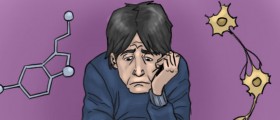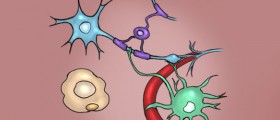
Acetylcholine
Acetylcholine is a neurotransmitter found in both the peripheral nervous system, where it activates the muscles, and the central nervous system, where it acts as a neuromodulator upon plasticity, arousal and reward. It is one of many neurotransmitters in the autonomic nervous system and the only neurotransmitter used in the motor division of the somatic nervous system.
Dopamine
Dopamine is a neurotransmittted that is produced in quite a few areas of the brain, including the substantia nigra and the ventral tegmental area. Dopamine is also a neurohormone released by the hypothalamus, the region of the brain responsible for dealing with stress, among other functions. Its principle hormonal role is to inhibit the release of prolactin from the anterior lobe of the pituitary. Dopamine has important roles in behavior and cognition, voluntary movement, motivation, punishment and reward, sleep, mood, attention, working memory and learning.
Serotonin
Serotonin is a monoamine neurotransmitter, usually found in the gastrointestinal tract, platelets and the central nervous system. This chemical is also known as the “happiness hormone”, because its releases arouses feelings of pleasure and well-being. Low levels of serotonin are associated with increased carbohydrate cravings, depression, sleep deprivations and hypersensitivity to pain. Bonding with friends, relatives, and partners helps release serotonin. It is also used to reduce feelings of depression.
Gamma Aminobutyric Acid (GABA)
Gamma Aminobutyric Acid is a protein that in humans is encoded by the GABRA1 gene. GABA acts at inhibitory synapses in the brain by binding to specific transmembrane receptors in the plasma membrane of both pre and postsynaptic neuronal processes. The primary role of this neurotransmitter is to slow down the neuron activity. Synthetically, GABA is now often used to help treat anxiety disorders.
Glutamate
This is the most abundant excitatory neurotransmitter in the vertebrate nervous system. It is also the major excitatory transmitter in the brain, and major mediator of excitatory signals in the mammalian central nervous system, involved in most aspects of normal brain functions including cognition, memory and learning.
Epinephrine and Norepinephrine
These are two separate but related hormones secreted by the medulla of the adrenal glands. These chemicals are also produced at the ends of sympathetic nerve fibers, where they serve as chemical mediators for conveying the nerve impulses to effector organs. They are responsible for concentration, attention, mood and both physical and mental arousal. Epinephrine is used to treat people with anaplylatic shock, for instance, while norepinephrine can help patients whose blood pressure has dropped to dangerously low levels quickly.
Endorphins
Endorphins are produced by the pituitary gland and the hypothalamus in vertebrates during exercise, excitement, when a person is in pain, during and after the consumption of spicy food, when feeling love, and during orgasm. Endorphins contribute to the feeling of well-being and act similarly to opiates. They are also known to reduce pain and anxiety, and can make a person feel very energetic.













_f_280x120.jpg)


Your thoughts on this
Loading...